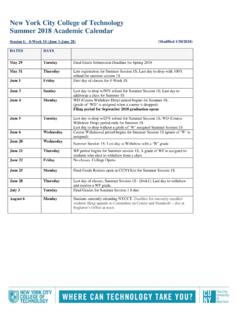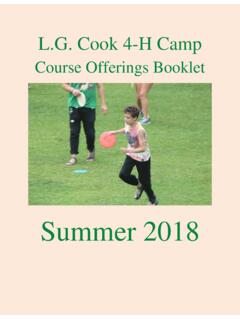Transcription of Incoming 6 Grade Math Summer Packet - Welcome …
1 Incoming 6th Grade math Summer Packet Packet Due Date: August 24-25, 2015 Dear Carver students and parents, This Summer , we encourage you to continue to practice your mathematics at home. Being actively involved in mathematical activities enhances learning. In preparation for the 2015-2016 school year, students are provided with a Summer review Packet . This Packet focuses on some of the prerequisite concepts and skills necessary for student success in 6th Grade advanced mathematics. The Packet may be graded at the teacher s discretion and receive extra credit.
2 While completing the review Packet , we recommend that students: Complete each problem, and show all steps used to arrive at the final answer. Show all work neatly in the actu al Packet , if it is printed.(Additional li ned paper may be added if necessary.) If Packet is not printed, then make sure to number each page and problem as it appears on thepacket. All work must be neatly presented. Box y our final answers. Round to nearest place value when directed to do so. Label answers when necessary. Do not use a calculator. Do not rush! Use time wisely. If you are stuck on particular problems, check out of the math websites posted below.
3 Parentsmay also be able to help. If you are still having difficulty, circle the problem number and beprepared to ask questions in class in APP: Virtual Nerd Mobile Requirements: iOS or l ater; compatible with iPhone, iPad, and iPod Touch Feature s: Virtual Nerd s on-screen instructors provi de clear and approachable explanations; students can mark favorite videos so that they can instantly return to them in the future. HELPFUL WEBSITES: ht org/ ht com ht tp:/ / math . comPrice: Free Have a fun and productive ,G. W. Carver Mathematics Department1 3 13 7 2 1 8 5 2 5 Summer Packet 5th into 6th Grade Name _____ Example: + 345 + 525 + 268 Decimal Addition: Remember to line up the decimals before adding.
4 Bring the decimal straight down in your answer. 4. + + + Example: 7. 8. 9. 407 7,007 3,414 - 198 -2,426 -1,218 Decimal Subtraction: Remember to line up the decimals before subtracting. Bring the decimal straight down in your answer. 10. 11. 12. 4 - 1 1 448+ 188636 Subtraction Find the difference between the two numbers in each problem. Show all work. Addition Find the sum of the two numbers in each problem. Show all work. 2 5 4 x 1 6 3 2 4 + 5 4 0 8 6 4 Example: 13.
5 14. 15. 65 42 84 x 4 x 8 x 39 Decimal Multiplication: Multiply as you would with whole numbers. Count the decimal places in each factor. The product (answer) has the same number of decimal places. 16. 17. 18..13 .108 x 70 x 2 x 19. 20. 21. 7591 12264 432815 Division Find the quotient in each problem. If there is a remainder, state the remainders as R= . Show all work. Feel free to use a separate sheet of paper. Multiplication Find the product of the two numbers in each problem. Show all work.
6 3 quotientdividenddivisorDecimal Division: If the divisor (outside number) is a decimal, you must move the decimal point (using multiplication) to the right until it becomes a whole number. Then, move the decimal in the dividend (inside number) the same number of times. Divide to find your answer (quotient). Then, move the decimal straight up from the dividend to the quotient. Remember, no remainders. 22. 23. 24.. to the hundredth27. whole Compare the decimals. 31. 33. 35. 36.
7 Round to the hundredth Rounding Underline the given place value. Look to the right. If this digit is 5 or greater, increase the underlined digit by 1. If the digit to the right is less than 5, keep the underlined digit the same. Compare using <, >, or = = 4 Determine if the following numbers are prime or composite. If the numbers are composite, please list all of the factors. : : : : _____ Solve the following expressions by writing the expanded notation (repeated multiplication) and find the value. cubedExponents A way to show repeated multiplication by the same factor is to use an exponent.
8 In this example: 23 = 2 x 2 x 2 = 8. The small raised three is the exponent. It tells how many times the number 2, called the base, is multiplied by itself. Prime Number: A whole number greater than 1 that has only two factors, 1 and itself. Examples: 2, 3, 5, 7, 11, 13, 17, and 19 are all prime numbers. Composite Number: A whole number greater than 1 that has more than two factors. Example: 8 is a composite number since its factors are 1, 2, 4, 8. 5 List all the factors for each number. Circle the common factors. : _____30 : _____ Common Factors: Greatest Common Factor: _____ : _____45 : _____ Common Factors: Greatest Common Factor: _____ : _____29: _____ Common Factors: Greatest Common Factor: _____ : _____72: _____ Common Factors: Greatest Common Factor: _____ Finding Common Factors: 4: 1, 2, 4 20: 1, 2, 4, 5, 10, 20 Common Factors: 1, 2, 4 GCF= 4 Greatest Common Factor The greatest factor that two or more numbers have in common (GCF).
9 All the factors of four in all the factors of twenty in the common the greatest common factor 6 50. 8 : _____ 12 : _____ Common Multiples: Least Common Multiple: _____ 51. 7 : _____ 11 : _____ Common Multiples: Least Common Multiple: _____ 52. 25 : _____ 10 : _____ Common Multiples: Least Common Multiple: _____ 53. 24 : _____ 36: _____ Common Multiples: Least Common Multiple: _____ Finding Common Multiples: 4: 4, 8, 12, 16, 20, 24 6: 6, 12, 18, 24, 30, 36 Least Common Multiple= 12 Least Common Multiple The smallest nonzero multiple that two or more numbers have in common.
10 1. List the first 6 multiples of 4 2. List the first 6 multiples of 6 3. List the common multiples 4. Write the least common multiple. 7 54. 55. 56. 57. Prime Factorization is a composite number renamed as a product of prime numbers. You may make a factor tree to find the answer. Put final answer in exponent form. Find the prime factorization of 36. 36 / \ 6 x 6 / \/ \ 2 x 3 2 x 3 22 x 3291 180 525 48 8 Comparing Fractions Compare each pair of numbers. Write the correct comparison symbol ( , >, = ) in each circle.










